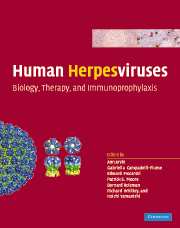Book contents
- Frontmatter
- Contents
- List of contributors
- Preface
- Part I Introduction: definition and classification of the human herpesviruses
- Part II Basic virology and viral gene effects on host cell functions: alphaherpesviruses
- Part II Basic virology and viral gene effects on host cell functions: betaherpesviruses
- Part II Basic virology and viral gene effects on host cell functions: gammaherpesviruses
- Part III Pathogenesis, clinical disease, host response, and epidemiology: HSV-1 and HSV-2
- Part III Pathogenesis, clinical disease, host response, and epidemiology: VZU
- Part III Pathogenesis, clinical disease, host response, and epidemiology: HCMV
- Part III Pathogenesis, clinical disease, host response, and epidemiology: HHV- 6A, 6B, and 7
- Part III Pathogenesis, clinical disease, host response, and epidemiology: gammaherpesviruses
- Part IV Non-human primate herpesviruses
- 57 Monkey B virus
- 58 Simian varicella virus
- 59 Primate betaherpesviruses
- 60 Gammaherpesviruses of New World primates
- 61 EBV and KSHV-related herpesviruses in non-human primates
- Part V Subversion of adaptive immunity
- Part VI Antiviral therapy
- Part VII Vaccines and immunothgerapy
- Part VIII Herpes as therapeutic agents
- Index
- Plate section
- References
60 - Gammaherpesviruses of New World primates
from Part IV - Non-human primate herpesviruses
Published online by Cambridge University Press: 24 December 2009
- Frontmatter
- Contents
- List of contributors
- Preface
- Part I Introduction: definition and classification of the human herpesviruses
- Part II Basic virology and viral gene effects on host cell functions: alphaherpesviruses
- Part II Basic virology and viral gene effects on host cell functions: betaherpesviruses
- Part II Basic virology and viral gene effects on host cell functions: gammaherpesviruses
- Part III Pathogenesis, clinical disease, host response, and epidemiology: HSV-1 and HSV-2
- Part III Pathogenesis, clinical disease, host response, and epidemiology: VZU
- Part III Pathogenesis, clinical disease, host response, and epidemiology: HCMV
- Part III Pathogenesis, clinical disease, host response, and epidemiology: HHV- 6A, 6B, and 7
- Part III Pathogenesis, clinical disease, host response, and epidemiology: gammaherpesviruses
- Part IV Non-human primate herpesviruses
- 57 Monkey B virus
- 58 Simian varicella virus
- 59 Primate betaherpesviruses
- 60 Gammaherpesviruses of New World primates
- 61 EBV and KSHV-related herpesviruses in non-human primates
- Part V Subversion of adaptive immunity
- Part VI Antiviral therapy
- Part VII Vaccines and immunothgerapy
- Part VIII Herpes as therapeutic agents
- Index
- Plate section
- References
Summary
Introduction
Numerous Gamma-herpesviruses, a large subfamily of the herpes group, have limited pathogenic potential upon primary infection of their natural host. They are most relevant however as tumor viruses of the hematopoietic system and form an important chapter of viral oncology. The prototype of the genus lymphocryptovirus (γ1-herpesvirus), Epstein-Barr Virus (EBV), was the first clearly identified human herpesvirus. EBV causes lymphomas of B-cell origin and other lymphoproliferative syndromes, nasopharyngeal carcinomas and, possibly, gastric cancer. The second known genus of gamma-herpesviruses, rhadinoviruses or γ2-herpesviruses, is biologically and molecularly distinct. The prototypic members of this group, termed Herpesvirus (H.) saimiri (HVS) and H. ateles (HVA), were detected as T-lymphotropic tumor viruses in neotropical primates and raised primary interest from the fact that they cause fulminant T-cell lymphomas in numerous primates as well as in rabbits, although no exact correlates of these tumors exist in human pathology. This led to the identification of novel viral membrane-associated T-cell oncoproteins, termed Stp and Tip. These are small adaptor molecules that efficiently act on T-lymphocyte signaling. The viruses have been used as expression vectors in T-lymphocytes and allow to study mechanisms of episomal persistence in components of the T-cell system. Later on it became clear that certain strains of HVS can transform human T-lymphocytes to continuous growth in an antigen- and mitogen-independent fashion, providing for the first time a reliable means of human T-lymphocyte immortalization in cell culture.
- Type
- Chapter
- Information
- Human HerpesvirusesBiology, Therapy, and Immunoprophylaxis, pp. 1076 - 1092Publisher: Cambridge University PressPrint publication year: 2007
References
- 8
- Cited by

